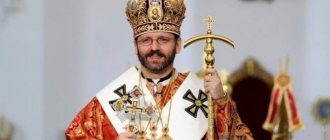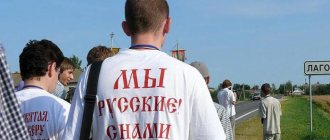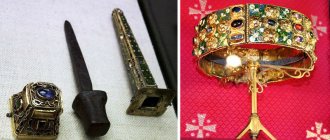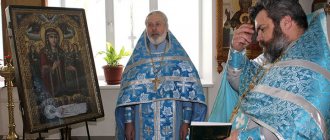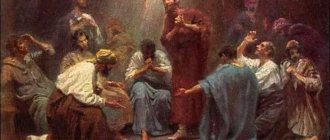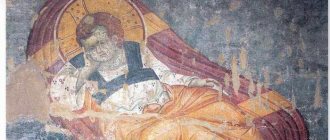This term has other meanings, see Metropolis of Kiev.
Russian Uniate Church
(lat.
Ecclesia Ruthena unita
, Polish.
Ruski Kościół Unicki
, Ukrainian. Ruska Uniyna Church, Belarusian Ruska Uniyatska Tserkva), also the
Kiev Metropolis within the Catholic Church
- a local Catholic church of the Greek rite, formed in the Polish-Lithuanian Commonwealth as a result of the Union of Brest.
For some time, about 1,600 churches in Hungary and Transylvania, as well as the Mukachevo Greek Catholic Diocese, were subordinated to the Kyiv Metropolis.
The liturgy used Church Slavonic and Western Russian written languages.
Now its legal successors are the Ukrainian and Belarusian Greek Catholic churches.
Story
In 988, Prince Vladimir Svyatoslavich introduced Christianity in its Greek rite as the state religion in the Old Russian state. This happened before the great schism of 1054 divided Christian East and West. The Kiev Church inherited the traditions of the Byzantine East and was part of the Patriarchate of Constantinople. However, the Kiev Church also remained in full liturgical communion with the Latin West and its patriarch, the Pope.
Despite the fact that there were disagreements between Constantinople and Rome, the Kyiv hierarchs tried to maintain Christian unity. Envoys from Rus' took part in the councils of the Western Church in Lyon (1245) and Constance (1418). Kiev Metropolitan Isidore himself was one of the initiators of the Union of Florence.
Part of the clergy and laity in the Grand Duchy of Moscow refused to recognize the Union of Florence and separated from the Kyiv Metropolis, proclaiming their autocephaly (self-government) in 1448 and forming a separate metropolitanate with its center in Moscow. In 1589, taking advantage of the decline of Greek Orthodoxy and the fact that Constantinople was under Turkish domination, the Church in Moscow received the status of a patriarchate.
The Uniate Church on the territory of the Polish-Lithuanian Commonwealth was formed after the conclusion of the Union of Brest in 1596.
Most of the bishops of the Kyiv Metropolis, led by Metropolitan Mikhail Rogoza, supported the Union of Brest, as a result of which the Metropolis was resubordinated to the Pope, managing to retain all the dioceses in its composition. At the same time, the opponents of the union also preserved the Orthodox church organization, which led to the parallel existence of two Kyiv metropolises: Greek Catholic and Orthodox. Orthodox protests against the transfer of churches and monasteries to the union were expressed in the form of literary polemics, debates at diets, fraternal movements, as well as open protests up to and including uprisings, among which were the Mogilev uprisings of 1618 and the Vitebsk uprisings of 1623. In turn, the Uniate Church, in order to increase its influence among the population, created its own system of educational institutions and church brotherhoods, actively participated in literary polemics, and was engaged in book publishing.
Already in 1601 in Vilna, Metropolitan of Kiev, Galicia and All Rus' Ipatiy Potsey founded the first theological seminary of the Russian Uniate Church at the Trinity Monastery.[1]
In general, the Uniate Church enjoyed state support, although it was considered second-class, which was evidenced in particular by the non-inclusion of the largest Greek Catholic hierarchs in the Senate.
Gradually, the authority of the Uniate Church grew, which was facilitated by the creation of the Order of Basilians, as well as the transition to Greek Catholicism by Meletius Smotrytsky. Since the 1630s, the gentry began to lean towards union. In the 1630s, Metropolitan Joseph of Rutsky attempted to create a united Uniate-Orthodox Kyiv Patriarchate, but the project was unsuccessful. Despite efforts to spread the union, in 1647 in the Polish-Lithuanian Commonwealth there were about 4 thousand Uniate and more than 13.5 thousand Orthodox parishes[2].
The dedication of the Patriarch of Jerusalem Theophan III in 1620 to the new Orthodox hierarchy in the Polish-Lithuanian Commonwealth (before this, bishops were not allowed to the cathedra by King Sigismund III), the division of religious institutions in 1635 by the charter of Vladislav IV between the Orthodox and Uniate churches approved the division of the Eastern Church into 2 legal metropolises of Kiev - Uniate and Orthodox and consolidated the confessional split of Western Russian (Belarusian-Ukrainian) society. Attempts to reconcile him were made at the councils of 1629 in Kyiv and 1680 in Lublin, convened on the initiative of the Uniate hierarchy, but were ignored by the Orthodox. In the 1630s, Metropolitan Joseph of Rutsky hatched a project to create a patriarchate on the basis of the Kyiv Metropolis, common to the Orthodox and Uniate churches, which interested Orthodox opponents, including Peter Mogila. But this idea did not meet with the support of the papacy, the government of the Polish-Lithuanian Commonwealth, and did not find understanding among the Orthodox population.
During the war between the Polish-Lithuanian Commonwealth and Russia of 1654-1667, the union was banned in the territories occupied by Russian troops. After the Truce of Andrusovo in 1667, the ruling circles of the Polish-Lithuanian Commonwealth sharply increased support for the union. To an even greater extent, the growth of its attractiveness in the eyes of the gentry was facilitated by the subordination of the Kyiv Orthodox Metropolis to the Moscow Patriarchate in 1688, which meant the loss of independence of the Orthodox Church of the Polish-Lithuanian Commonwealth and its complete subordination to the interests of Russia, the enemy in the recent war. Especially support for the Uniate Church and at the same time pressure on the Orthodox Church from the central government increased during the reign of Jan Sobieski. In 1692 the union was adopted by the Przemysl diocese, in 1700 by the Lviv diocese, and in 1702 by the Lutsk diocese. At the same time, the Uniate population of the Polish-Lithuanian Commonwealth exceeded the Orthodox population[2].
In the 18th century, the gradual Latinization of the Uniate Church began, expressed in the adoption of the Latin rite, which contradicted the conditions of the Brest Council of 1569. The agents of Latinization were the Basilians, who came mainly from Polish Catholic families. Of particular importance was the Zamoyski Council held in 1720, which decided to unify worship by accepting liturgical books approved by the papal authority and refusing to use non-Catholic publications. After 1720, two trends emerged in Uniateism: supporters of the first sought to borrow Roman Catholic traditions, the second - to preserve their own Western Russian Orthodox traditions and purity of ritual[2].
From 1729 to 1795, the residence of the Uniate metropolitans was the city of Radomyshl. On March 5, 1729, the nominee and administrator of the Kyiv Uniate Metropolis, Bishop Atanasy Sheptytsky, took possession of Radomyshl, who later in the same year became metropolitan.
In 1791, on the territory of the Grand Duchy of Lithuania, Uniates made up 39% of the population, and on the territory of modern Belarus - 75% (in rural areas - more than 80%) [3]
The majority of the followers of the Uniate Church were peasants. In addition, part of the townspeople and small gentry were Uniates[4].
After the divisions of the Polish-Lithuanian Commonwealth, when most of the territory of the dioceses of the Uniate Church became part of the Russian Empire, some Greek Catholics joined the Orthodox Russian Church, and some remained subordinate to Rome.
The general direction of the policy of all Russian emperors was inflexible. Parishioners of the Russian Greek Catholic Church were viewed as Orthodox who, under pressure, accepted the jurisdiction of the Pope, and who, under any pretext, were inclined to violate this jurisdiction. Already during the reign of Catherine II, there was widespread activity to convert Greek Catholics to Orthodoxy in the lands of Lithuania and Belarus[5]. In 1787, Catherine II decreed that only printing houses subordinate to the Synod could print spiritual books in the Russian Empire, and the activities of Greek Catholic printing houses ceased. In 1794, Orthodox Bishop Viktor Sadkovsky sent out appeals calling on Greek Catholics to convert “to the right faith,” which were read in cities and villages as acts of state. If there were those who wanted to convert to Orthodoxy, then the authorities wrote them down in the books, paid them a monetary allowance and sent a priest with a detachment of soldiers who confiscated the church from the Greek Catholics and handed them over to the Orthodox, and expelled the Greek Catholic priests along with their families. It was ordered to abolish Greek Catholic parishes if less than 100 households were assigned to them, but if they wanted to convert to Orthodoxy, they were allowed to exist. The Greek Catholic dioceses, with the exception of Polotsk, were abolished, and the bishops were sent into retirement or abroad.
After a break during the reigns of Paul I and Alexander I, the fight against the union continued again with Emperor Nicholas I[6]. The administrative liquidation of the Uniate Church was preceded by a long campaign to bring Uniate rites closer to the Orthodox, which was coordinated by the Lithuanian Bishop Joseph Semashko. In 1839, at the synod in Polotsk, the Greek Catholic Church in Lithuania and Belarus was liquidated. The only Uniate diocese in the Russian Empire remained the Kholm diocese. It was liquidated in 1875[7].
Terminology
The term "Uniate", as previously stated, is applied to Eastern Catholic churches that formerly belonged to the Oriental or Oriental Orthodox Churches or, in rare cases, to the Assyrian Church of the East. The term is sometimes considered derogatory, but was nevertheless often used by Roman and Eastern Catholics until the Second Vatican Council. Official Catholic documents no longer use the term due to its negative reputation associated with criticism of the Uniate Church. According to John Erickson of St. Vladimir's Orthodox Theological Seminary, the very term "Uniate," once used proudly in Roman communication, has long been considered pejorative. The “Eastern Rite” is also no longer held in high esteem among the Uniates, since it created the illusion that the Uniates are some kind of “wrong” Catholics, different from their Western counterparts.
The Second Vatican Council affirmed that Eastern Catholics form part of the United Catholic Church and should serve as a bridge between the West and the East. The Uniates noted this, rejoicing at such a favorable attitude towards themselves from Rome. Today the term is used in all languages of the world to refer to Greek Catholics.
Primates
Main article: List of primates of the Russian Uniate Church
- Mikhail Rogoza (July 27, 1589—1599)
- Ipatiy Potsey (September 26, 1599 - July 18, 1613)
- Joseph Rutsky (April 5, 1614 - February 5, 1637)
- Raphael Korsak (1637 - August 28, 1640)
- Anton Selyava (March 18, 1641 - October 5, 1655)
- Gabriel Kolenda (April 24, 1665 – February 11, 1674)
- Cyprian Zhokhovsky (February 11, 1674 - October 26, 1693)
- Lev Slyubich-Zalensky (September 22, 1695 - August 24, 1708)
- Yuri Vinnitsky (May 7, 1710 - September 22, 1713)
- Lev Kishka (September 17, 1714 - November 19, 1728)
- Atanasy Sheptytsky (August 18, 1729 - December 12, 1746)
- Florian Grebnitsky (December 16, 1748 - July 18, 1762)
- Philip Volodkovich (July 18, 1762 - February 12, 1778)
- Lev Sheptytsky (1778-1779)
- Jason Smogorzewski (1780-1788)
- Theodosius Rostotsky (November 1, 1788 - January 25, 1805)
Church structure
After the Union of Brest in 1596, the Kiev and Polotsk archdioceses and the Pinsk, Lutsk, Vladimir and Kholm dioceses became Uniate. The Lviv and Przemysl dioceses did not accept the union. After the death of Bishop Kirill of Terletsky in 1607, the Lutsk diocese gradually moved away from the union, returning to it in 1702 with Bishop Dionysius of Zhabokritsky. After the capture of Smolensk by Polish troops in 1616, the king nominated Lev Krevza as Archbishop of Smolensk in 1625, thereby founding the Uniate Smolensk Archdiocese. In 1691, the Przemysl diocese with Bishop Innocent of Vinnitsa joined the Uniate Kyiv Metropolis, and in 1700 the Lviv diocese with Bishop Joseph Shumlyansky joined.
- Kyiv Archdiocese
- Polotsk Archdiocesebe-tarask
- Smolensk Archdiocese
- Pinsk and Turov diocese
- Lutsk and Ostrog diocese
- Vladimir and Brest diocese
- Kholm diocese
- Lviv diocese
- Przemysl Diocese
By the time of the divisions of the Polish-Lithuanian Commonwealth, the Russian Uniate Church numbered 9,300 parishes, 10,300 priests and 4.5 million parishioners (while the entire population of the Polish-Lithuanian Commonwealth was 12.3 million people [8]). In addition, the Uniate Church owned 172 monasteries with 1,458 monks[2].
Historical background
Before the Uniate Church arose, the Catholic Church experienced a lot of conflicts with the Eastern (Orthodox) Church.
The fellowship of the Christian churches was disrupted by differences in matters of faith, with each side accusing the other of heresy or departure from the true faith (“orthodoxy”). Communion was disrupted due to disagreement over issues of power and the legitimacy of the election of a particular bishop. In these latter cases, each side accused the other of schism, but not of heresy.
Notes
- Turilov A. A., Florya B. N.
On the question of the historical alternative to the Union of Brest // [www.inslav.ru/resursy/elektronnaya-biblioteka/553—1596-xvi-xvii-2-1999 Union of Brest 1596 and socio-political struggle in Ukraine and Belarus at the end of the 16th - first half of the 17th century]. - M., 1999. - T. II. — P. 28. - ↑ 1234
Uniyatskaya Tsarva // Vyalikae Principality of Lithuania. Encyclopedia in 3 volumes - Mn.: BelEn, 2005. - T. 1: Abalenski - Kadency. — P. 114—116. — 684 p. — ISBN 985-11-0314-4. - Anatol Grytskevich. Uniyatskaya tsarva in Belarus from the end of the XVIII century to the beginning of the XIX century // Khrystsiyanskaya Duma, No. 3 (214), 1993, p. 119.
- History of Belarus (shasci tamakh). Belarus at the clock of Rechy Paspalіtai (XVII-XVIII centuries). T. 3. - Minsk: “Ekaperspectyva”, 2004. P. 302-303
- Radwan, 2004, p. 24-25.
- Osadczy, 2007, p. 351-353.
- Osadczy, 2007, s. 355-356.
- Kuklo C.
Demografia Rzeczypospolitej Przedrozbiorowej - Warsawa: Wydawnictwo DiG, 2009. - 518 p. — P. 211. (Polish)
The emergence of the Uniate Church
After the fall of Constantinople, people appeared in Europe who wanted to restore the unity of the Catholic and Orthodox churches. In 1438, the Council of Florence took place, at which a long debate took place on theological differences between the two churches. The reason for this dispute was the desire of some cardinals and theologians to restore church unity.
Several European Orthodox churches eventually linked themselves to Rome, forming the Eastern Catholic Churches. Catholic Rome accepted them without requiring them to adopt the customs of the Latin Church, so that they all have their own liturgical, theological, spiritual and disciplinary heritage determined by culture and historical circumstances. A Uniate priest, for example, wears the same vestments as Orthodox ministers.
Literature
- Uniyatskaya Tsarva // Vyalikae Principality of Lithuania. Encyclopedia in 3 volumes - Mn.: BelEn, 2005. - T. 1: Abalenski - Kadency. — P. 114—116. — 684 p. — ISBN 985-11-0314-4. (Belorian)
- Dmitriev M.V., Florya B.N., Yakovenko S.G. Union of Brest 1596 and social and political. struggle in Ukraine and Belarus in the end. XVI - beginning XVII century M., 1996
- Kuklo C.
Demografia Rzeczypospolitej Przedrozbiorowej - Warsawa: Wydawnictwo DiG, 2009. - 518 p. — P. 211. (Polish) - Anatol Grytskevich. Uniyatskaya tsarva in Belarus from the end of the XVIII century to the beginning of the XIX century // Khrystsiyanskaya Duma, No. 3 (214), 1993, p. 119. (Belor.)
- Labyntsev Yu. A. Shchavinskaya L. L. SOME CIRCUMSTANCES AND MEANS OF SUPPORTING THE BELARUSIAN-UKRAINIAN UNIATE LITURGICAL PRACTICE IN THE XVII-XIX CENTURIES // Ancient Rus'. Questions of medieval studies. 2000. No. 2. P. 124-136.
- History of Belarus (shasci tamakh). Belarus at the clock of Rechy Paspalіtai (XVII-XVIII centuries). T. 3. - Minsk: “Ekaperspektyva”, 2004. P. 302-303 (Belarus)
- [ia700409.us.archive.org/31/items/beresteiskauniia00liko/beresteiskauniia00liko.pdf Likovsky Edward. Beresteysk Union (1596). — Zhovkva: Printing. oo. Vasiliyan, 1916. - 336 pp.]
- Gudziak B. Crisis and reform: Metropolis of Kiev, Tsargorod Patriarchate and the genesis of the Berestia Union. — Lviv: Institute of History of the Church of Lviv. Theological Academy, 2000. (Ukrainian)
- S. Senyk, The Ukrainian Church and Latinization. - Orientalia Christiana Periodica, 56, 1990. pp. 165-187.
- Marian Radwan.
Carat wobec Kościoła greckokatolickiego w zaborze rosyjskim 1796-1839. - Lublin: Instytut Europy Środkowo-Wschodniej, 2004. - ISBN 839176155X. - Włodzimierz Osadczy.
Święta Ruś. Rozwój i oddziaływanie idei prawosławia w Galicji. - Lublin: Wydawnictwo Uniwersytetu Marii Curie-Skłodowskiej, 2007. - ISBN 9788322726723.
Excerpt characterizing the Russian Uniate Church
- A? Right?..what do you think, or leave it? Or not? - Would you like to turn it back? - Turn back, turn back! - Count Orlov suddenly said decisively, looking at his watch, “it will be late, it’s quite light.” And the adjutant galloped through the forest after Grekov. When Grekov returned, Count Orlov Denisov, excited by this canceled attempt, and by the vain wait for the infantry columns, which still did not show up, and by the proximity of the enemy (all the people of his detachment felt the same), decided to attack. He commanded in a whisper: “Sit down!” They distributed themselves, crossed themselves... - With God! “Hurray!” - there was a rustle through the forest, and, one hundred after another, as if pouring out of a bag, the Cossacks flew cheerfully with their darts at the ready, across the stream to the camp. One desperate, frightened cry from the first Frenchman who saw the Cossacks - and everyone in the camp, unclothed and sleepy, abandoned their cannons, rifles, horses and ran anywhere. If the Cossacks had pursued the French, not paying attention to what was behind and around them, they would have taken Murat and everything that was there. The bosses wanted this. But it was impossible to move the Cossacks from their place when they got to the booty and prisoners. Nobody listened to the commands. One thousand five hundred prisoners, thirty-eight guns, banners and, most importantly for the Cossacks, horses, saddles, blankets and various items were immediately taken. All this had to be dealt with, the prisoners and guns had to be seized, the booty had to be divided, shouting, even fighting among themselves: the Cossacks did all this. The French, no longer being pursued, began to gradually come to their senses, gathered in teams and began to shoot. Orlov Denisov expected all the columns and did not advance further. Meanwhile, according to the disposition: “die erste Colonne marschiert” [the first column is coming (German)], etc., the infantry troops of the late columns, commanded by Bennigsen and controlled by Toll, set out as they should and, as always happens, arrived somewhere , but not where they were assigned. As always happens, people who had gone out cheerfully began to stop; Displeasure was heard, a sense of confusion was heard, and we moved somewhere back. The adjutants and generals who rode by shouted, got angry, quarreled, said that they were completely in the wrong place and were late, scolded someone, etc., and finally, everyone gave up and went off only to go somewhere else. “We’ll come somewhere!” And indeed, they came, but not to the right place, and some went there, but were so late that they came without any benefit, only to be shot at. Toll, who in this battle played the role of Weyrother at Austerlitz, diligently galloped from place to place and everywhere found everything topsy-turvy. So he galloped towards Baggovut’s corps in the forest, when it was already quite daylight, and this corps should have been there long ago, with Orlov Denisov. Excited, upset by the failure and believing that someone was to blame for this, Tol galloped up to the corps commander and sternly began to reproach him, saying that he should be shot for this. Baggovut, an old, militant, calm general, also exhausted by all the stops, confusions, contradictions, to the surprise of everyone, completely contrary to his character, flew into a rage and said unpleasant things to Tolya. “I don’t want to take lessons from anyone, but I know how to die with my soldiers no worse than anyone else,” he said and went forward with one division. Having entered the field under French shots, the excited and brave Baggovut, not realizing whether his entry into the matter now was useful or useless, and with one division, went straight and led his troops under the shots. Danger, cannonballs, bullets were exactly what he needed in his angry mood. One of the first bullets killed him, the next bullets killed many soldiers. And his division stood for some time under fire without benefit. Meanwhile, another column was supposed to attack the French from the front, but Kutuzov was with this column. He knew well that nothing but confusion would come out of this battle that had begun against his will, and, as far as it was in his power, he held back the troops. He didn't move. Kutuzov rode silently on his gray horse, lazily responding to proposals to attack. “You’re all about attacking, but you don’t see that we don’t know how to do complex maneuvers,” he said to Miloradovich, who asked to go forward. “They didn’t know how to take Murat alive in the morning and arrive at the place on time: now there’s nothing to do!” - he answered the other. When Kutuzov was informed that in the rear of the French, where, according to the Cossacks’ reports, there had been no one before, there were now two battalions of Poles, he glanced back at Yermolov (he had not spoken to him since yesterday). “They ask for an offensive, they propose various projects, but as soon as you get down to business, nothing is ready, and the forewarned enemy takes his own measures.” Ermolov narrowed his eyes and smiled slightly when he heard these words. He realized that the storm had passed for him and that Kutuzov would limit himself to this hint. “He’s having fun at my expense,” Ermolov said quietly, nudging Raevsky, who was standing next to him, with his knee. Soon after this, Ermolov moved forward to Kutuzov and respectfully reported: “Time has not been lost, your lordship, the enemy has not left.” What if you order an attack? Otherwise the guards won’t even see the smoke. Kutuzov said nothing, but when he was informed that Murat’s troops were retreating, he ordered an offensive; but every hundred steps he stopped for three quarters of an hour. The whole battle consisted only in what Orlov Denisov’s Cossacks did; the rest of the troops only lost several hundred people in vain. As a result of this battle, Kutuzov received a diamond badge, Bennigsen also received diamonds and a hundred thousand rubles, others, according to their ranks, also received a lot of pleasant things, and after this battle even new movements were made at headquarters. “This is how we always do things, everything is topsy-turvy!” - Russian officers and generals said after the Tarutino battle, - exactly the same as they say now, making it feel like someone stupid is doing it this way, inside out, but we wouldn’t do it that way. But people who say this either do not know the matter they are talking about or are deliberately deceiving themselves. Every battle - Tarutino, Borodino, Austerlitz - is not carried out as its managers intended. This is an essential condition. An innumerable number of free forces (for nowhere is a person freer than during a battle, where it is a matter of life and death) influences the direction of the battle, and this direction can never be known in advance and never coincides with the direction of any one force. If many, simultaneously and variously directed forces act on some body, then the direction of movement of this body cannot coincide with any of the forces; and there will always be an average, shortest direction, what in mechanics is expressed by the diagonal of a parallelogram of forces. If in the descriptions of historians, especially French ones, we find that their wars and battles are carried out according to a certain plan in advance, then the only conclusion that we can draw from this is that these descriptions are not correct. The Tarutino battle, obviously, did not achieve the goal that Tol had in mind: in order to bring troops into action according to disposition, and the one that Count Orlov could have had; to capture Murat, or the goals of instantly exterminating the entire corps, which Bennigsen and other persons could have, or the goals of an officer who wanted to get involved and distinguish himself, or a Cossack who wanted to acquire more booty than he acquired, etc. But , if the goal was what actually happened, and what was a common desire for all Russian people then (the expulsion of the French from Russia and the extermination of their army), then it will be completely clear that the Tarutino battle, precisely because of its inconsistencies, was the same , which was needed during that period of the campaign. It is difficult and impossible to imagine any outcome of this battle that would be more expedient than the one it had. With the least tension, with the greatest confusion and with the most insignificant loss, the greatest results of the entire campaign were achieved, the transition from retreat to offensive was made, the weakness of the French was exposed and the impetus that Napoleon’s army had only been waiting for to begin their flight was given. Napoleon enters Moscow after a brilliant victory de la Moskowa; there can be no doubt about victory, since the battlefield remains with the French. The Russians retreat and give up the capital. Moscow, filled with provisions, weapons, shells and untold riches, is in the hands of Napoleon. The Russian army, twice as weak as the French, did not make a single attack attempt for a month. Napoleon's position is most brilliant. In order to fall upon the remnants of the Russian army with double forces and destroy it, in order to negotiate an advantageous peace or, in case of refusal, to make a threatening movement towards St. Petersburg, in order, even in case of failure, to return to Smolensk or Vilna , or stay in Moscow - in order, in a word, to maintain the brilliant position in which the French army was at that time, it would seem that no special genius is needed. To do this, it was necessary to do the simplest and easiest thing: to prevent the troops from looting, to prepare winter clothes, which would be enough in Moscow for the entire army, and to properly collect the provisions that were in Moscow for more than six months (according to French historians) for the entire army. Napoleon, this most brilliant of geniuses and who had the power to control the army, as historians say, did nothing of this. Not only did he not do any of this, but, on the contrary, he used his power to choose from all the paths of activity that were presented to him that which was the stupidest and most destructive of all. Of all the things that Napoleon could have done: winter in Moscow, go to St. Petersburg, go to Nizhny Novgorod, go back, north or south, the way that Kutuzov later went - well, whatever you can come up with, is stupider and more destructive than what he did Napoleon, that is, to remain in Moscow until October, leaving the troops to plunder the city, then, hesitating, to leave or not to leave the garrison, to leave Moscow, to approach Kutuzov, not to start a battle, to go to the right, to reach Maly Yaroslavets, again without experiencing the chance of breaking through , to go not along the road that Kutuzov took, but to go back to Mozhaisk and along the devastated Smolensk road - nothing more stupid than this, nothing more destructive for the army could be imagined, as the consequences showed. Let the most skillful strategists come up with, imagining that Napoleon’s goal was to destroy his army, come up with another series of actions that would, with the same certainty and independence from everything that the Russian troops did, would destroy the entire French army, like what Napoleon did. The genius Napoleon did it. But to say that Napoleon destroyed his army because he wanted it, or because he was very stupid, would be just as unfair as to say that Napoleon brought his troops to Moscow because he wanted it, and because that he was very smart and brilliant. In both cases, his personal activity, which had no more power than the personal activity of each soldier, only coincided with the laws according to which the phenomenon took place. It is completely false (only because the consequences did not justify Napoleon’s activities) that historians present to us Napoleon’s forces as weakened in Moscow. He, just as before and after, in the 13th year, used all his skill and strength to do the best for himself and his army. Napoleon's activities during this time were no less amazing than in Egypt, Italy, Austria and Prussia. We do not know truly the extent to which Napoleon’s genius was real in Egypt, where forty centuries they looked at his greatness, because all these great exploits were described to us only by the French. We cannot correctly judge his genius in Austria and Prussia, since information about his activities there must be drawn from French and German sources; and the incomprehensible surrender of corps without battles and fortresses without siege should incline the Germans to recognize genius as the only explanation for the war that was waged in Germany. But, thank God, there is no reason for us to recognize his genius in order to hide our shame. We paid for the right to look at the matter simply and directly, and we will not give up this right. His work in Moscow is as amazing and ingenious as everywhere else. Orders after orders and plans after plans emanate from him from the time he entered Moscow until he left it. The absence of residents and deputations and the very fire of Moscow do not bother him. He does not lose sight of the welfare of his army, nor the actions of the enemy, nor the welfare of the peoples of Russia, nor the administration of the valleys of Paris, nor diplomatic considerations about the upcoming conditions of peace. In military terms, immediately upon entering Moscow, Napoleon strictly orders General Sebastiani to monitor the movements of the Russian army, sends corps along different roads and orders Murat to find Kutuzov. Then he diligently gives orders to strengthen the Kremlin; then he makes an ingenious plan for a future campaign across the entire map of Russia. In terms of diplomacy, Napoleon calls to himself the robbed and ragged captain Yakovlev, who does not know how to get out of Moscow, sets out to him in detail all his policies and his generosity and, writing a letter to Emperor Alexander, in which he considers it his duty to inform his friend and brother that Rastopchin made bad decisions in Moscow, he sends Yakovlev to St. Petersburg. Having outlined his views and generosity in the same detail to Tutolmin, he sends this old man to St. Petersburg for negotiations. In legal terms, immediately after the fires, it was ordered to find the perpetrators and execute them. And the villain Rostopchin is punished by being ordered to burn his house. In administrative terms, Moscow was granted a constitution, a municipality was established and the following was promulgated: “Residents of Moscow! Your misfortunes are cruel, but His Majesty the Emperor and King wants to stop their course. Terrible examples have taught you how he punishes disobedience and crime. Strict measures are taken to stop the disorder and restore everyone's safety. The paternal administration, elected from among yourself, will constitute your municipality or city government. It will care about you, about your needs, about your benefit. Its members are distinguished by a red ribbon, which will be worn over the shoulder, and the city head will have a white belt on top of it. But, except during their office, they will only have a red ribbon around their left hand. The city police were established according to the previous situation, and through its activities a better order exists. The government appointed two general commissars, or chiefs of police, and twenty commissars, or private bailiffs, stationed in all parts of the city. You will recognize them by the white ribbon they will wear around their left arm. Some churches of different denominations are open, and divine services are celebrated in them without hindrance. Your fellow citizens return daily to their homes, and orders have been given that they should find in them help and protection following misfortune. These are the means that the government used to restore order and alleviate your situation; but in order to achieve this, it is necessary that you unite your efforts with him, so that you forget, if possible, your misfortunes that you have endured, surrender to the hope of a less cruel fate, be sure that an inevitable and shameful death awaits those who dare to your persons and your remaining property, and in the end there was no doubt that they would be preserved, for such is the will of the greatest and fairest of all monarchs. Soldiers and residents, no matter what nation you are! Restore public trust, the source of happiness of the state, live like brothers, give mutual help and protection to each other, unite to refute the intentions of evil-minded people, obey the military and civil authorities, and soon your tears will stop flowing.”



